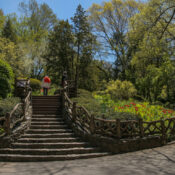Gapstow Bridge spans the Pond in the southeast corner of the Park.
Its rustic stone construction, much of which is covered in vines, blends in with the surrounding landscape. The bridge brings visitors over the narrow neck of the Pond and is also a popular spot for enjoying an overview of scenery and taking photographs.
To the south is the striking juxtaposition of the dramatic skyline of Central Park South with the Park’s verdant landscapes; to the west, the rugged, woody hill of the Hallett Nature Sanctuary; and to the north, Wollman Rink. The current Gapstow Bridge was built in 1896 to replace a more elaborate bridge with distinctive cast-iron elements that deteriorated.
Central Park’s arches and bridges are an integral part of its circulation system. The Park’s designers, Frederick Law Olmsted and Calvert Vaux, created an intricate system of pedestrian paths, a bridle path, and carriage drives to allow visitors to experience the Park’s landscapes in a variety of ways. However, for this system to work safely and in a relatively small space, it had to limit interactions between potentially conflicting forms of traffic. The Park’s arches and bridges separate this traffic by carrying one form of transportation over another.
Between 1859 and 1866, 27 arches and bridges were built in Central Park. All were designed by Vaux—in some cases with the assistance of fellow architect Jacob Wrey Mould. Each one is unique, designed with various materials and decorative motifs and with careful consideration of its placement in the landscape. Over time, six arches and bridges were added and three were removed, bringing the total to 30 ornamental bridges and arches in the Park today. There are also additional bridges in the Park’s woodlands that are smaller, constructed with wood, and typically cross over streams.
Another key part of this circulation system are the transverse roads that allow City traffic to cross the Park. The transverse roads are sunken below the grade of the Park with bridges crossing over them. These bridges were designed as more utilitarian structures and weren’t intended to be seen—but they allow pedestrians and other traffic to seamlessly move through the Park. There are 13 transverse road bridges (one of which, Denesmouth, is also considered an ornamental bridge).






3 Comments
It is a fascinating place, there is life on the lake, New York culture is bursting around. we loved it very much thank you
Omg we were fascinated, it is a magnificent place with its nature and stories. Very close to hotel plaza and central park zoo. Take lots of photos.
Our guide and driver were friendly and knowledgeable. He knows the park like the back of his hand, but the park is enormous.